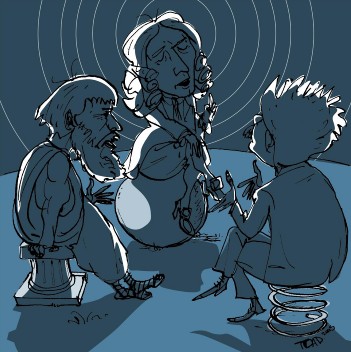Newton:
It’s like this: actually, the Moon would like to move straight on, because that is its natural movement — always straight on and always constant for all eternity, or at least until some external force stops it from moving in this way. This is what I have called the principle of inertia. Then, gravity comes along and pulls the Moon down a little. At the same time, however, the Moon strives to go straight on, and then falls down a little bit more towards the Earth because of its gravity. The result of this zigzagging, which happens so fast that you don’t see it, is the Moon’s near-circular orbit.
Aristotle:
Why keep it simple when you can have it complicated! It is as though the Moon were a slave and gravity a sort of shackle.
 Scene
Scene


 1st Slide
1st Slide
 Branching Point
Branching Point
 Module: Dialogue on Mount Olympus
Module: Dialogue on Mount Olympus Sequence: 0.0.0 START dialog
Sequence: 0.0.0 START dialog Branching Point: Dialogue on Mount Olympus
Branching Point: Dialogue on Mount Olympus Slide: On the Shoulders of Giants and Dwarfs
Slide: On the Shoulders of Giants and Dwarfs Back
Back


